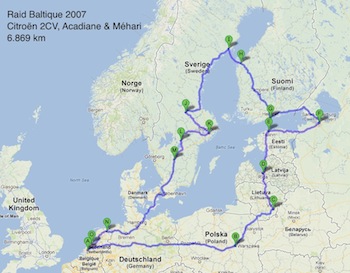
nearly 7.000 km from the Netherlands through the Baltic states, the center of Europe and St. Petersburg
to the worldmeeting of 2CV's in Sweden during the summer of 2007.
The number of cars and even the route were unsure until the last moment. Ten countries, amongst which the Baltic states, nine capitals, the center of Europe, and St. Petersburg were finally on the menu. We called it Raid Baltique and expected to drive at least 5.000 km.
The preparations for the journey consisted of course of the preparation of the cars, application for visa for Russia, thinking through what spare parts to take along, and studying foreign traffic rules. For example: in Estonia it is oligatory to carry two wheel blocks on board.
Furthermore there is a Citroën Méhari and a Citroën 2CV going along. Rudi's Méhari is a 1980 model and has been completely overhauled last year. Tim's Duck used to be a 2CV4 from 1978, but lives on as a 2CV6 with a few rallye modifactions.
On the 13th July this colourful caravan stands ready at the startline in Zevenhuizen near Rotterdam.
The first day is the most boring. Nearly 700 km over motorways are on
the programme. Rudi has spent the evening before we left with mounting
a new engine in his Méhari and therefore we don't drive faster
than 90
km/h untill we reach the German border. At that point Rudi declares
the engine suitable for the real work.
Germans invented driving cars, but on our way we see particularly many
accidents. In the heat of the day a lot of cars have stranded on the
hard shoulder of the Autobahn with a defect cooling system.
Rudi and Tim are faster than the German ADAC and help the Citroën
AX of a young Dutch couple on the road again. We deliberately keep Berlin
to the left.
The owner of the lovely little campsite in the East-German Kolpin has
worked for six years in the Rotterdam Waalharbour (next to our 2CV-club).
For the next days the radio forecasts a heat wave. The holiday has begun!


On the Polish inner roads we experience total anarchy, but after a while we adept completely and happily join in with the dangerous looking menace in which it is important to take over as much as possible cars and lorries at once, even when there is oncoming traffic.
The toll motorway after Poznan is almost a delight, but this is unfinished at its eastern end, so ik takes us several hours to reach what may be called one of the ugliest capitals of Europe.
We leave the Polish plains in a small strip between oblast Kaliningrad and Belorussia through the quiet borderstation of Ogrodniki. Welcome to Lithuania! After several kilometers we already have fallen in love with the landscape. We are overtaken by Lithuanians who happily sound the horns of their cars, waving and taking pictures. They apparantly seem to appreciate our presence. In the villages the same scenes of people waving and picture taking.
According to our navigation system the shortest route to Vilnius is along gravel roads. That is not strange when you leave the main road. In the former capital Trakai we put up our tents on a beautiful campsite on the shores of a lake overlooking the castle of the former Lithuanian kings.
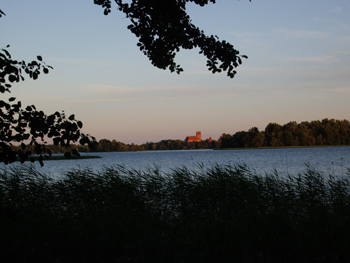
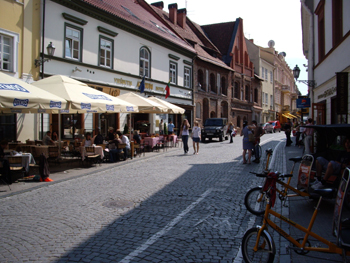
The
capital of the catholic Lithuania lays rather peripheral in the country,
near the border to nabouring Belorussia. The city shows its urge to change.
The cathedral and the facades in the city are renovated; the old trolley
buses are replaced by new ones; shops and cafés are numerous and
new; Lithuanians are young, hip and modern.
We are impressed by so much business. They want to sell Soviet memorabilia
to tourists, but we expect to find that in Russia. For the salmon
and the trout we pay a fraction of what it would have cost us in a restaurant
back home.
We start the day with the - most likely - geographical center of Europe
at 54.54 N en 25.19 E.
The decadent but very affordable lunch on the terrace of the Italian restaurant
of the golfclub Centros Europos tastes excellent. The waiter tells us
that today with its 37 graden C is the hottest day in Lithuanian history.
The Baltic states are proud members of the EU. We see a lot of investments
in infrastructure, the reason why we drive on so much fresh asphalt on
the main routes.
At
the gas stations they don't sell 98 octane, but the old AM2-engine of
the Acadiane has no problems with 95 octane. At the border with Latvia
we are asked for the first time to show our car papers, followed by a
quick inspection of our number plates.
In the rush hour traffic of Riga we encounter a lot of new, big and luxurious
Western cars mostly of well known German brands. That the former Hanseatic
city Riga is booming, we notice at the evening in the
city centre. The old town is free of cars; at every corner there are well
populated terraces. Music, food and beer are everywhere to be found. Riga
bubbles over with life, but Latvia with its German roots is still looking
for an identity.

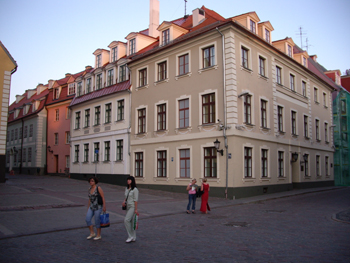
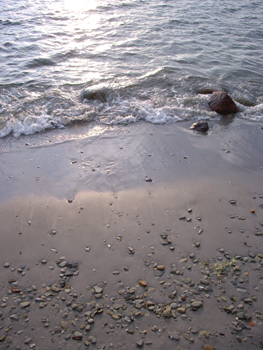
Riga
topped Vilnius – what will Tallinn bring us? The calm Baltic sea
lays to our left after leaving the city. The wind lets dance our A-types
a little on the road today.
We eat our daily lunch after passing the border in a hard to find truckstop
in Uulu. Here stands firm: are there trucks parked outside, than the food
must be good. We can strongly recommend the double schnitzels!
In Estonia we come across the first Lada's. Russia comes closer.
In
the busy city traffic - like in Riga - the gas pedals in the 2CV and the
Acadiane tend to get stuck a little. Tallinn looks more simple; the annual
economic groth of 7% does not show immediately. In het heart of the old
town the terraces are full too. The city is on the outskirts of Europe,
but thanks to the good ferry connections to Helsinki and Stockholm Scandinavia
is closeby.
Despite the fact that we had to comply to all the necessary formalities home in the NL to enter Russia, here on the border they add some more. Estonia out takes half an hour, Russia in takes three. Apart from the amount of office windows, stop signs and barriers we have to pass, the indifference stands out with which Russians seem to act comfortably. One officer hands out a incomprehensible Russian form which we try to decipher with the help of an assisting Estonian. The next officer yells at us (in Russian of course) how we get it in our heads to fill out a form we couldn’t understand, while there are understandable English versions available?
Furthermore
we are made clear with hands and feet that they want to know if we carry
any psychedelic goods. And yes, those wooden shoes Rudi has in his car
are very ‘exotic’ and nearly fail to get into the country.
Tim is stealing the show with his compact rally car, at least five unformed
caps are examining his 2CV with utmost admiration.
The drive to St. Petersburg passes over some bad stretches of road, but
after several tens of kilometers the surface gets better. In the evening
rush hour in St. Petersburg we are photografed a dozen of times from the
sidewalk, through the shaded windows of Lada’s. The passengers of
an entire city bus sit turned around and taking pictures with their cell
phones. Quirine knows how to get us through the city with an old city
map of Leningrad from 1990.
At arrival at the Olgino hotel annex camp site we receive a message from
the NL that Jeroen
Cats has died in a car accident. We all are shaken by that news.




We planned two whole days for Sankt Peterburg. After a bus and underground trip the four of us stand - and I after 17 years again - on Nevski Prospect and around us are colours, shops, terraces, advertising and people. Two days are the minimum for a visit to this city. A visit to the Hermitage with its art collection of over 3 million pieces costs alomost a day alone.
In Russia no one sells Soviet memorabilia anymore. Or haven't we looked good enough?
On our last evening on the camp site we are approached by a German couple that is interested in our cars and our stories. They appear to be on their journey home after travelling the silk route of Marco Polo in Central Asia. This journey took them one and a half year, including a stay of several months in Afghanistan to work as volunteers for a school project. We seem to be good listeners for their stories.
Near the border I am surprised by the two police officers with barrier and nail strip who compliment us with our beautiful cars. The customs officer who shows us the right line to stand in, first takes pictures of our cars with his cell phone. The border passing is chaotic again. Custom forms have to be filled in, but were not handed out to us. A bus load of French take pictures of us, but a customs officer notifies them to stop immediately. The Russian customs computer jams during Tim’s processing, while behind us a row with mostly 15 Fins starts to grow. A Danish woman clearly lost her way and drives circles on the site in her Renault Clio. I see enough ingredients for a Louis de Funès en Russie, but after an hour we stand in the vast no-man’s-land between Russia and Finland.
On the Finnish border
laughing seems allowed again. Rudi has a good entering, because he is
promoting the Finnish gothic band Nightwish on his shirt. On
the camp site in Helsinki we unintentionally take the places of three
French 2CV’s who left that morning.
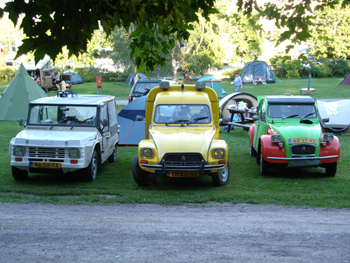

A minor panic spreads amongst us – except for Tim, he does not feel the need to be at the worldmeeting on the first day. His travel mates have another opinion on that and after overlooking the alternatives later that day in a travel agency we book a ferry from Vaasa to Umeå for the next morning.
The extra 1.000 km that we have to drive, we take for granted. The planned day out in Helsinki has to be skipped, except for a lunch in the Lasipalatsi, because we still have 400 km to Vaasa in the North ahead of us.
The
night was a short one, because we want to be on time at the ferry which
leaves at 8 o'clock in the morning. The breakfast with a sandwich with
fish does not land good in everybody's stomach. The hour time difference
between Finland and Sweden confuses us, but means that the boat takes
an hour longer for the crossing than we thought.
When we arrive in Sweden at 11 am local time, we have 600 km in southern
direction laying ahead of us. That's a rather long stretch of road. We
get to it. During daytime there is a lot of texting with those who are
still in line for the meeting and those who are already keeping spaces
for our tents. On the last kilometers Rudi cannot control himself anymore.
After Tim has registered we enter the worldmeeting in half an hour.
In the distance our friends and co-members of our club are already waving at us – I get goose bumps. The reception after 4.450 km is very friendly; everybody seems to have followed us in the internet and is interested in our stories. With a couple of beers we start telling. The most important is that we reached the worldmeeting without a single problem!
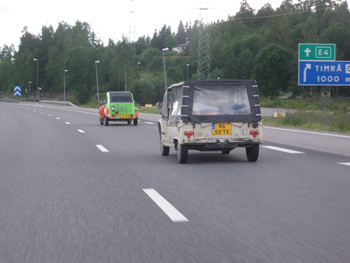

Our self organised Raid was a pretty success. The three cars have completed the journey without any stress. Our technical prepartion was good. The spare parts we took along could stay in their boxes. The journey was an extraordinary experience through new countries and passing mostly friendly people. Driving along we found out that it had been even more fun if we had had more time to sniff up more impressions. That is what we learned for the next journey per 2CV. We even have a goal already.
In two weeks time we crossed nine countries and drove 4.450 km with a
2CV, a Méhari and an Acadiane to reach Borlänge - without
a single technical problem. On returning home after three weeks the Acadiane
had driven through 10 countries and had 6.869 km under its wheels.
More pictures of the Raid and of the worldmeeting can be found on my picturepage.
On Youtube you can watch the film
of the journey (duration 15 minuten).
This travelstory has appeared in printed version in the September/Oktober 2007 edition of the club magazine of V.A.G. Het Eendeëi. More information about this journey and other journeys and meetings can be found on www.2cvtravel.nl.


back to the main page of glimeend.nl

